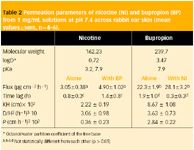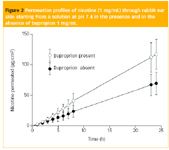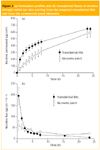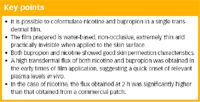Transdermal film containing nicotine and bupropion for combined smoking cessation therapy
Pharmaceutical Technology Europe
Smoking-related illness is a major public health problem, and there is great impetus to develop effective therapies to help stop smoking and maintain abstinence.1–4 Two types of pharmacological therapies have been approved by FDA for smoking cessation:2 nicotine replacement therapy (NRT), which substitutes nicotine from cigarettes with safer nicotine-containing formulations; and bupropion administration,5–7 which is an atypical antidepressant that can significantly increase abstinence rate.

NRT is designed to help smokers quit by reducing withdrawal symptoms.8–10 All commercially available forms of NRT are effective as part of a strategy to promote smoking cessation,8,9,11 even though the quit rate is far from 100% (ranging from 14% to 25% after 12 months). Bupropion is a safe and effective non-nicotine alternative first-line treatment.12
Bupropion is a weak inhibitor of dopamine and noradrenaline re-uptake, and has been shown to antagonize nicotinic acetylcholine receptor function.13 When administered with intensive behavioural support, bupropion is as effective as NRT and also reduces the weight gain that often occurs after a smoker quits.
Because of the limited quit rate with single therapy, a combined therapy of nicotine and bupropion has also been tested in several clinical trials.15–18 Treatment with oral sustained-release bupropion combined with a nicotine patch resulted in a higher rate of long-term smoking cessation compared with a placebo, and also with a single treatment of either nicotine or bupropion alone. While nicotine is currently administered in different formulations (i.e., transdermal patches, inhalers, chewing-gums, tablets), bupropion is available in tablet form only. The development of a transdermal dosage form containing both actives could be of great interest to the study of smoking cessation. Additionally, bupropion transdermal administration could avoid the risk of seizures associated with peak plasma concentration.19
The aim of this work was to evaluate the transdermal penetration characteristics of the two drugs — alone and in combination — and to prepare and test a transdermal system that could deliver both nicotine and bupropion through the skin. Rabbit ear skin was used as the barrier in permeation experiments as it can be regarded as a reasonable model for human skin in vitro.20–22
Materials
Nicotine was purchased from Merck (Darmstaadt, Germany) and bupropion HCl from Sigma (St. Louis, USA). Polyvinyl alcohol (PVA) (MW=83400; degree of hydrolysis 86–89 mol%) was obtained from Nippon Ghosei (Osaka, Japan) and Polyvynil pyrrolidone K90 (PVP) was received from BASF (Ludwigshafen, Germany). For high performance liquid chromatography (HPLC) analysis, acetonitrile (HPLC grade) (Carlo Erba; Milan, Italy) and distilled water were used. All other chemicals used were of analytical grade.
Method
Skin preparation. Rabbit ear skin was used as the barrier. The skin from the inner part of the ear of a rabbit (6 months old) was obtained from a local slaughterhouse, frozen and used within 30 days.
Film preparation and characterization. PVA was hydrated in the appropriate volume of water to a final concentration of 20% (w/w). PVP was dissolved (21% w/w) in 15 mL of a mixture of polyethylene glycol (PEG) 400:water (15:85 w/w) and the appropriate amount of bupropion or nicotine was added. This solution was mixed with 80 g of PVA solution under continuous stirring. The resulting mixture was spread on siliconized paper (Rexam Release; Apeldoom, NL, USA), using a film-casting knife (BYK Gardner; Silversprings, MD, USA) with a gap of 400 μm, and then left to dry at room temperature overnight. Two different combined films (A and B) were prepared using a fixed concentration of nicotine and two different concentrations of bupropion.
Once dried, three circles (26 mm in diameter) were cut from each film. Each circle was weighted and dissolved in 100 mL of a solution of 0.1 N HCl. The solutions obtained were analysed by HPLC to determine the amount of nicotine and bupropion contained in the patch. The results were expressed as %(w/w) and as mg/cm2 .
HPLC analysis. HPLC analyses were performed with validated methods, using a Perkin Elmer instrument (Norwalk, CT, USA) and a Novapak C18 column (Waters; Milford, MA, USA). The UV detector was set at 254 nm.
The mobile phase for nicotine was a mixture of 1 M CH3COONa, 0.25 M sodium dodecyl sulphate, water and CH3CN (1:1:68:30 v:v) pumped at 1.5 mL/min.
The mobile phase for bupropion was methanol (40% v/v) and 0.1 M sodium acetate containing 0.01 M tetrabutylammonium bromide to pH 5.0 (60% v/v), pumped at 1.0 mL/min.

Table 1
Permeation experiments. Permeation experiments were conducted in Franz-type diffusion cells (Disa; Milan, Italy) with an exposed surface area of 0.6 cm2 . Rabbit ear skin was used as membrane and the receptor phase was 0.9% NaCl solution. The donor solutions tested were: 1 mg/mL solution of bupropion HCl in pH 7.4 HEPES buffer; 1 mg/mL solution of nicotine in pH 7.4 HEPES buffer; nicotine and bupropion hydrochloride (both 1 mg/mL) solution in pH 7.4 HEPES buffer; nicotine and bupropion containing transdermal films Table 1); and Nicorette commercial patch (Pharmacia & Upjohn; Milan, Italy) (Table 1).

Table 2
Data analysis. The profiles obtained from the solutions of bupropion and nicotine were analysed with Equation 1, a solution of Fick's second law of diffusion in a homogeneous membrane:10

where Q(t) is the amount of drug permeated as function of time, K is the partition coefficient, H is the diffusional path-length, Cd is the donor concentration and D is the diffusion coefficient.
The fitting was performed with n equal to 10, using Kaleidagraph software (Synergy Software; Reading, PA, USA) on a Power G3 MacIntosh computer (Apple Computer; Cupertino, CA, USA). The permeation parameters (KH and D/H2 ) calculated for the two molecules are presented in Table 2. KH gives an indication of the partitioning of the molecule between the stratum corneum and the formulation, while D/H2 represents the diffusive parameter. The permeability coefficient (P) was calculated as KH×D/H2 .
The results were expressed as the mean±sem. Statistical differences were determined by the Student's t-test, which assess whether the means of two groups are statistically different from each other.

Figure 1
Results and discussion
Permeation from solution. At first, the transdermal penetration of bupropion and nicotine was studied individually, starting from 1 mg/mL aqueous solutions at pH 7.4. Both nicotine and bupropion are basic drugs with a pKa of 7.9 (Table 2). At the pH of the experiment, 76% of each drug was in its protonated form (the value estimated from the Henderson-Hasselbach equation). The permeation profiles obtained are presented in Figure 1 (bupropion) and Figure 2 (nicotine). Bupropion showed good permeation characteristics and very short lag time, but after approximately 6 h the permeation rate seemed to decrease, probably as a result of the depletion of the donor compartment. After 24 h, approximately 60% of the amount applied had permeated the skin. The profile of nicotine permeation remained linear up to 24 h (Figure 2). In this case, the percentage permeated after 24 h was approximately 10%. Fluxes were calculated as the slope of the linear portion of the curves and are shown in Table 2.

Figure 2
As the aim of this work was to formulate nicotine and bupropion in a single transdermal film, the next step was to evaluate their reciprocal influence on transdermal permeation. This was done by measuring the transdermal flux of each drug from a solution containing both. The profiles obtained (Figures 1 and 2) showed a slight increase for both permeants. This increase is not statistically significant and suggests the absence of any reciprocal influence on their transdermal penetration, as confirmed by the flux data reported in Table 2.
The permeation profiles of both molecules were then analysed to calculate the relevant parameters, thanks to an appropriate solution of Fick's second law of diffusion in a homogeneous membrane (Equation 1, applied 0–24 h for nicotine and 0–6 h for bupropion). The permeation parameters (KH and D/H2 ) calculated for the two molecules are presented in Table 2. KH gives an indication of the partitioning of the molecule between the stratum corneum and the formulation, while D/H2 represents the diffusive parameter. The permeability coefficient (P) was calculated as KH×D/H2 .
The permeability coefficient of bupropion was higher than that of nicotine, probably because of the higher lipophilicity of bupropion, as demonstrated by its logD value (Table 2). The permeability coefficient of nicotine at pH 7.0 reported in the literature across human skin (8.4×10-3 cm/h) is in agreement with our data on rabbit ear skin,23 which confirms that rabbit ear skin can be a reasonable model for human skin.20–22 To our knowledge, no data on bupropion transdermal permeation starting from a solution are present in the literature.
As a reference to discuss bupropion data obtained in the present work and the feasibility of bupropion transdermal administration, the minimum amount of drug necessary to maintain therapeutic plasma levels was calculated. From the total clearance (133 L/h) and the concentration at steady state (136 μg/L), the input rate was calculated as 18 mg/h.19 Considering an application area of 20 cm2 , and the permeability coefficient obtained in our study (0.0284 cm/h), a donor concentration of approximately 30 mg/mL would be necessary to achieve the therapeutic plasma concentration. It should be kept in mind that this calculation is only a rough estimate of the feasibility of bupropion transdermal delivery, considering that our data was obtained in vitro through animal skin.
Permeation from films. Initially, the permeation of nicotine was studied from the reference market product Nicorette. The commercial product tested is a drug in adhesive patch, containing nicotine at the dose of 8.3 mg/10 cm2 (830 µg/cm2 ). The claimed in vivo release is 5 mg/16 h, that is, 500 μg/cm2 over 16 h. The permeation profile obtained (Figure 3(a)) is not linear with time, but, as previously reported,24 decreases with time. This suggests a diffusional control of the polymeric matrix on nicotine release. The release rate obtained by plotting the amount permeated against the square root of time was 129 μg cm-2 h-0.5 , which agrees with the published data across human epidermis (119 μg cm-2 h-0.5 ).24
The amount permeated at 24 h was ≈600 μg/cm2 and represents 70% of the amount loaded, which is a surprisingly high percentage for a transdermal patch. Although effective, the transdermal systems containing nicotine show local adverse reactions that occur in 30% of patients. Reactions include irritation induced by occlusion; irritation or allergy to the delivery system (matrix and adhesive layer); and erythema or allergy caused by nicotine.25
To try to reduce these problems, we developed an innovative transdermal drug delivery system, a water-based and vapour-permeable bioadhesive film intended for transdermal delivery (Figure 4).26–30 The transdermal film called Patch-non-Patch is not adhesive in the dry state, but is adhesive when applied to wet skin and is also water permeable, which reduces the risk of skin irritation. The typical composition includes a film-forming agent (PVA), an adhesive (PVP) and a plasticizer (PEG 400). The water solution of all the components is spread on silicone paper and oven-dried to produce the final film. Film application requires preventive skin wetting to partly dissolve the adhesive and restore skin adhesiveness.

Figure 3
The skin adhesion properties of the film have been previously characterized.26 The value of adhesion force was in the range 0.6–1.8 N, while the work of adhesion was 9–30 mJ. The values of adhesion force were not significantly modified after 24 h of application on the skin in vivo and the film was still firmly attached to the skin.
Two different combined films were prepared (A and B), using a fixed nicotine concentration (similar to the commercial product), but with two different bupropion concentrations (Table 1). The permeation profiles obtained from the films are reported in Figure 3(a) and Figure 5. The nicotine permeation profile (Figure 3(a)) showed matrix-type kinetics and was comparable to the one obtained with the commercial product. However, the film presented a more pronounced initial 'burst' effect. The average nicotine flux in each sampling interval was calculated for the film and for the commercial patch, and the result is reported in Figure 3(b).

Figure 4
The two formulations produced different fluxes during the first two hours of the experiment, while thereafter the profiles were almost superimposable. In particular, the flux from the film was much higher during the first two hours, indicating the possibility to achieve a faster appearance of nicotine in plasma when administered in vivo. However, it should be underlined that a higher flux has a higher irritation potential because nicotine is skin irritant.

Key points
Nevertheless, the film prepared is water-based and non-occlusive, and these properties should lower the irritation potential (although only the in vivo skin irritation test can give the definite answer). As a result of the non-occlusivity of the film and to the volatility of nicotine, the partial vaporization of nicotine at the air interface during the wear period can be envisaged. This should be taken into account for future development of the product as the use of a non-occlusive backing can lead to a reduction of nicotine concentration because of volatility, thus reducing the performance of the film.

Figure 5
The permeation of bupropion from the two different films, A and B (Table 2), is reported in Figure 5. Using the low concentration patch, bupropion flux was quite low and the percentage permeated reached only 11% of the amount loaded. The increase in drug loading determined a proportional increase in the amount permeated, but the percentage permeated was not substantially different (15%).
In any case, the profiles are characterized by the absence of lag-time and by the presence of an initial 'burst' effect that could be useful for faster onset of the therapeutic effect. The low percentage of bupropion permeated from the patch is in disagreement with the good permeability characteristics shown by bupropion in solution. One possible explanation is that bupropion in the patch is present entirely in its ionized form (the pH of the patch is approximately 3.5). Owing to the low permeation rate, the requested input rate (6 mg/h) could not be achieved with the prepared films. However, because of the proportionality between the amount loaded and the cumulative amount permeated (observed also by Gondaliya et al.13 ) a therapeutically useful permeation rate can potentially be obtained by increasing drug loading.
Conclusions
Both bupropion and nicotine showed good permeation characteristics when applied to the skin in solution at pH 7.4, but the combination of the two substances did not significantly modify their transdermal flux.
The inclusion of the two substances in an innovative transdermal film resulted in particularly interesting findings because a high transdermal flux in the early times of patch application was obtained, suggesting a quick onset of the relevant plasma levels in vivo. In the case of nicotine, the flux obtained at 2 h was significantly higher than that obtained from the commercial patch. The fluxes obtained for bupropion are not able to generate therapeutic plasma levels, but the results suggest that the required flux could be achieved by increasing drug loading.
Acknowledgements
The authors would like to thank the University of Parma (Italy) and Lisapharma (Erba, Como, Italy) for financial support.
Sara Nicoli is assistant professor.
Serena Cella is a fellowship holder.
Vincenzo Aversa is a fellowship holder.
Patrizia Santi is full professor of technology all at the Department of Pharmacy, University of Parma (Italy).
References
1. E.W. Lee and G.E. D'Alonzo, Arch. Intern. Med., 153(1), 34–48 (1993).
2. R.L. Corelli and K.S. Hudmon, Crit. Care Nurs. Clin. North Am., 18(1), 39–51, xii (2006).
3. C.F. Lerman, J. Clin. Oncol., 23(2), 311–23 (2005).
4. W.H. Frishman et al., Cardiol. Rev., 14(2), 57–73 (2006).
5. S.M. Hall, et al., Arch. Gen. Psychiatry, 59(10), 930–9366 (2002).
6. K.J. Holm and C.M. Spencer, Drugs, 59(4), 1007–1024 (2000).
7. D. Jorenby, Drugs, 62 Suppl. 2, 25–35 (2002).
8. L. Stead and T. Lancaster, Int. J. Epidemiol., 34(5), 1001–1002 (2005).
9. C., Silagy et al., Cochrane Database Syst. Rev., (3), p CD000146 (2004). www.cochrane.org
10. I. Campbell, Thorax, 58(6), 464–465 (2003).
11. K. Ahijevych, Evid. Based Nurs., 8(1), 13 (2005).
12. H. McRobbie, M. Lee and Z. Juniper, Respir. Med., 99(10), 1203–1212 (2005).
13. C. Warner and M. Shoaib, Addict. Biol., 10(3), 219–231 (2005).
14. E. Roddy,. BMJ, 328(7438), 509–511 (2004).
15. I. Sampablo, et al., Monaldi Arch Chest Dis., 59(2), 71–176 (2003).
16. P.B. Gold, R.N. Rubey and R.T. Harvey, Am. J. Addict., 11(4), 315–331 (2002).
17. N.F. Woolacott et al., Health Technol. Assess., 6(16), 1–245 (2002).
18. D.E. Jorenby et al., N. Engl. J. Med., 340(9), 685–691 (1999).
19. A.J. Johnston et al., Drugs, 62 Suppl. 2, 11–24 (2002).
20. M. Artusi et al., J. Pharm. Sci., 93(10), 2431–2438 (2004).
21. S. Nicoli et al., J. Pharm. Sci., 92(7), 1482–1488 (2003).
22. S. Nicoli and P. Colombo, Ann. Pharm. Fr., 59(4), 227–231 (2001).
23. Z. Kuylenstierna and H. Thulin, Ann. Occup. Hyg,, 43(6), 405–413 (1999).
24. J.C. Olivier, S. Rabouan and W. Couet, Int. J. Pharm., 252(1-2), 133–140 (2003).
25. S. Irie, et al., J. Pharmacol. Sci., 102(1), 72–76 (2006).
26. C. Padula et al., J. Control. Release, 88(2), 277–85 (2003).
27. S. Nicoli et al., Skin Pharmacol. Physiol., 17(3),119–23 (2004).
28. S. Nicoli, P. Colombo and P. Santi, Aaps. J., 7(1), E218–23 (2005).
29. A. FemenÃa-Font, J. Pharm. Sci., 95(7), 1561–1569 (2006).
30. patchnonpatch.awardspace.com
31. D. Gondaliya, and K. Pundarikakshudu, AAPS PharmSciTech, 4(1), E3 (2003).

Drug Solutions Podcast: A Closer Look at mRNA in Oncology and Vaccines
April 30th 2024In this episode fo the Drug Solutions Podcast, etherna’s vice-president of Technology and Innovation, Stefaan De Koker, discusses the merits and challenges of using mRNA as the foundation for therapeutics in oncology as well as for vaccines.
Drug Solutions Podcast: Applying Appropriate Analytics to Drug Development
March 26th 2024In this episode of the Drug Solutions Podcast, Jan Bekker, Vice President of Business Development, Commercial and Technical Operations at BioCina, discusses the latest analytical tools and their applications in the drug development market.
INTERPHEX 2025: Use of Walk-In Chambers for Bio/Pharma Development and Manufacturing
April 2nd 2025Sitting down with the PharmTech Group at INTERPHEX 2025, Christopher Murphy, director of Global Business Development and Service Customer Support at Environmental Specialties, discusses the design and critical role of walk-in chambers in the bio/pharmaceutical industry.